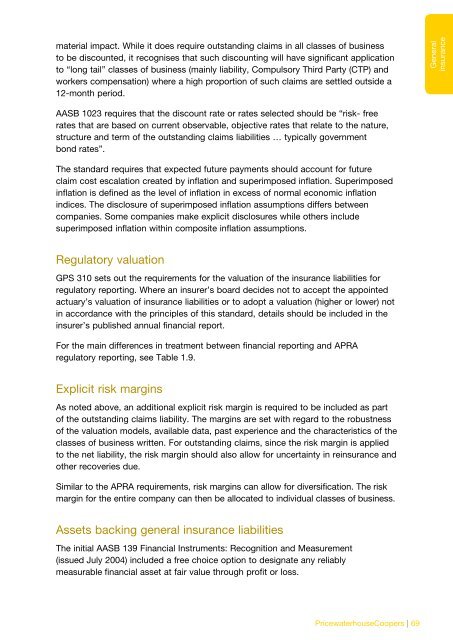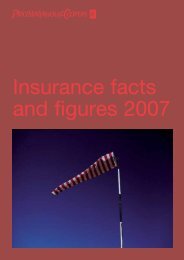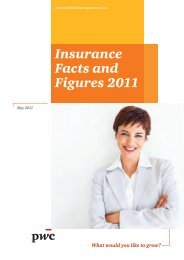Insurance - PricewaterhouseCoopers
Insurance - PricewaterhouseCoopers
Insurance - PricewaterhouseCoopers
You also want an ePaper? Increase the reach of your titles
YUMPU automatically turns print PDFs into web optimized ePapers that Google loves.
material impact. While it does require outstanding claims in all classes of business<br />
to be discounted, it recognises that such discounting will have significant application<br />
to “long tail” classes of business (mainly liability, Compulsory Third Party (CTP) and<br />
workers compensation) where a high proportion of such claims are settled outside a<br />
12-month period.<br />
AASB 1023 requires that the discount rate or rates selected should be “risk- free<br />
rates that are based on current observable, objective rates that relate to the nature,<br />
structure and term of the outstanding claims liabilities … typically government<br />
bond rates”.<br />
The standard requires that expected future payments should account for future<br />
claim cost escalation created by inflation and superimposed inflation. Superimposed<br />
inflation is defined as the level of inflation in excess of normal economic inflation<br />
indices. The disclosure of superimposed inflation assumptions differs between<br />
companies. Some companies make explicit disclosures while others include<br />
superimposed inflation within composite inflation assumptions.<br />
Regulatory valuation<br />
GPS 310 sets out the requirements for the valuation of the insurance liabilities for<br />
regulatory reporting. Where an insurer’s board decides not to accept the appointed<br />
actuary’s valuation of insurance liabilities or to adopt a valuation (higher or lower) not<br />
in accordance with the principles of this standard, details should be included in the<br />
insurer’s published annual financial report.<br />
For the main differences in treatment between financial reporting and APRA<br />
regulatory reporting, see Table 1.9.<br />
Explicit risk margins<br />
As noted above, an additional explicit risk margin is required to be included as part<br />
of the outstanding claims liability. The margins are set with regard to the robustness<br />
of the valuation models, available data, past experience and the characteristics of the<br />
classes of business written. For outstanding claims, since the risk margin is applied<br />
to the net liability, the risk margin should also allow for uncertainty in reinsurance and<br />
other recoveries due.<br />
Similar to the APRA requirements, risk margins can allow for diversification. The risk<br />
margin for the entire company can then be allocated to individual classes of business.<br />
Assets backing general insurance liabilities<br />
The initial AASB 139 Financial Instruments: Recognition and Measurement<br />
(issued July 2004) included a free choice option to designate any reliably<br />
measurable financial asset at fair value through profit or loss.<br />
<strong>PricewaterhouseCoopers</strong> | 69<br />
General<br />
insurance

















